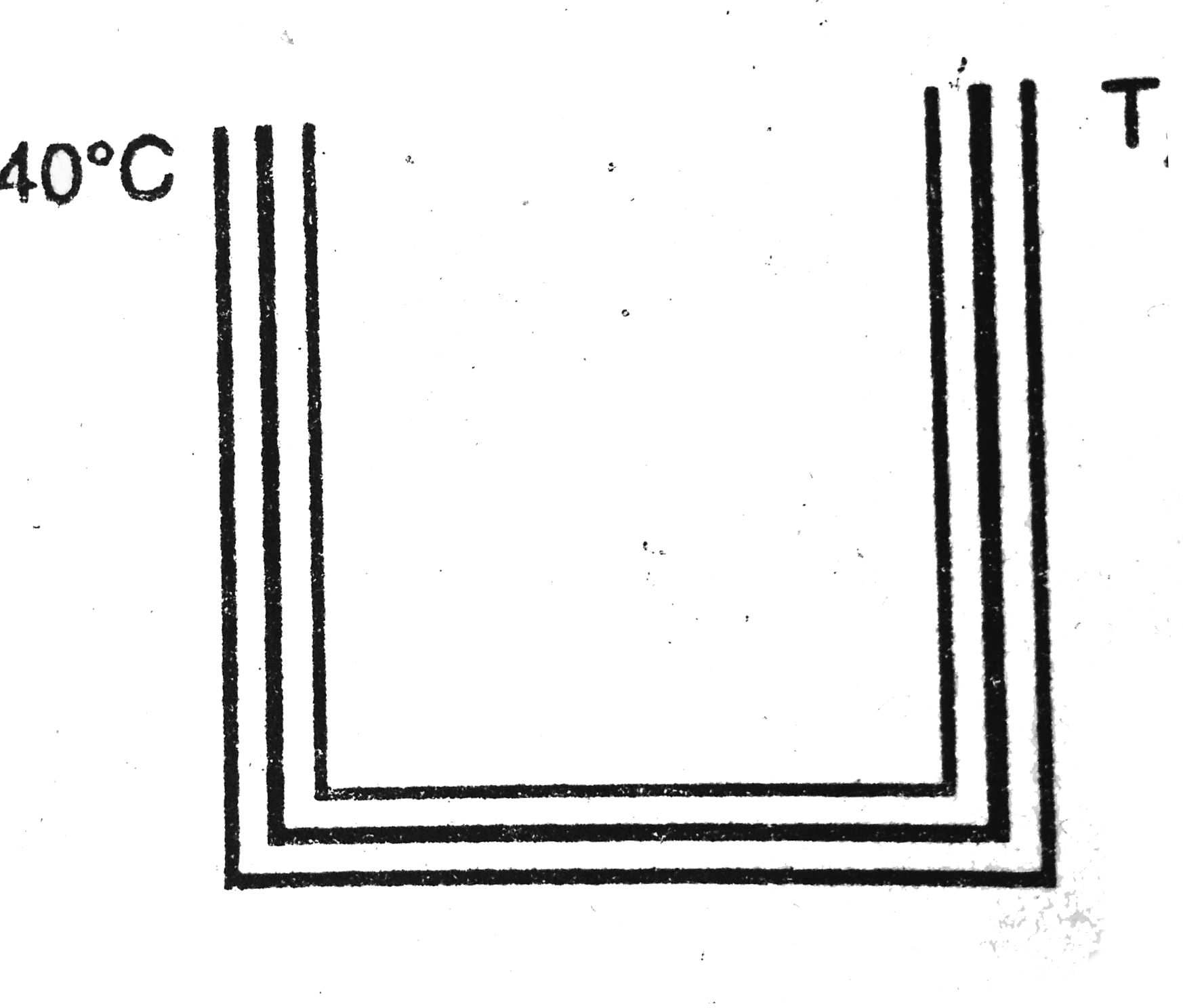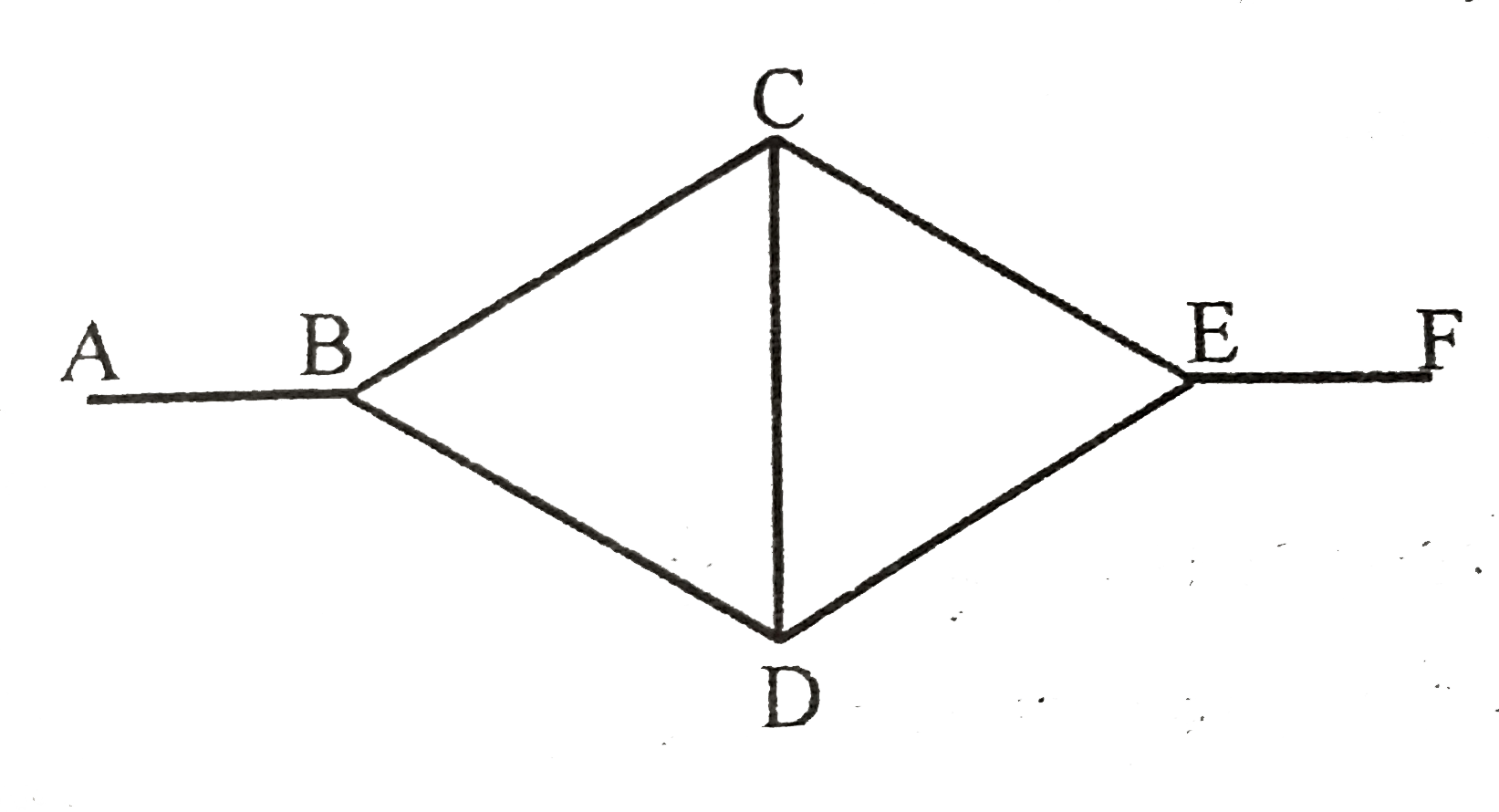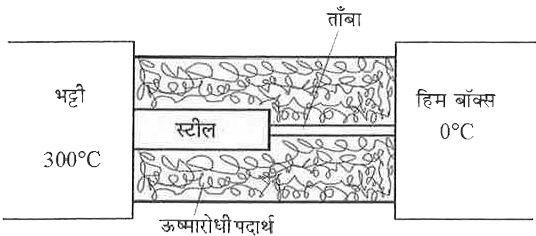A steel frame (K=45Wm−1C−1) of total length 60cm and cross sectional area 0.2cm2 , Forms three side of a square. The free ends are maintained at 20∘C and 40∘C . Find the rate of heat flow through a cross section of the frame. Solution in Tamil
The correct Answer is:C
K=45W/m−∘C,
1=60cm=60×10−2m
A=0.2cm2=0.2×10−4m2
Rate of heat flow,
kA(T1−T2)l=45×0.2×10−4×2060×10−2
=30×10−3=0.03W

Topper's Solved these Questions
Similar Questions
A centigrade and a Fahrenheit thermometer are dipped in boiling water. The water temperature is lowered until the Fahrenheit thermometer registered at 140°F. What is the fall in temperature as registered by the centigrade thermometer ?
View SolutionThe steam point and the ice point of a mercury thermometer are marked as 80∘C and 20∘C. What will be the temperature in centigrade mercury scale when this thermometer reads 32∘C?
View SolutionFind the dimensions of
a. linear momentum
b. frequency and
c. pressure
View SolutionThree rods of lengths 20cm eac h and area of cross section 1cm2 are joined to from a triangle ABC. The conductivites of the rods are kAB=50Js−1m−1(@)C^(-1),k_(BC)=200Js^(-1)m^(-1)(∘)C−1 , and kAC=400Js−1m−1(@)C^(-1).ThejunctionA,BandCarema∫a∈edat40^(@)C,80^(@)Cand80^(@)C respectivelt. Find the rate of heat flowing through the rods AB, AC and BC .
View SolutionConside the situation shown in figure. The frame is made of the same material and has a unifrom cross-section area everywhere. Calculate the amount of heat flowing per second through a cross section of the bent part if the total heat taken out per second from the end at 100∘C is 130J .

View SolutionA body of length 1 m having cross sectional area 0.75 m^(2) has heat flow through it at the rate of 6000 "Joule"//sec . Then find the temperature difference if K = 200 Jm^(-1) K^(-1) .
View SolutionThree rods of copper, brass and steel are joined together to form T shape as shown in figure. The cross sectional area of each rod is 4cm^(2) the end of copper rod is maintained at 10^(@)C and the ends of brass and steel rods at 0^(@)C assume there is no loss of heat to surrounding. What is temperature of junction point A in .^(@)C
View SolutionA metal frame of total length 50cm ad croos-sectional area 0.20cm2 froms five sides of a regular hexagon. The free ends are maintained at 20∘C and 40∘C. Find the rate of heat flow through a cross-section of the frame (K=50W/m∘C)
View Solution(a) Three rod of lengths 20cm each and area of cross-section 1cm2 are joined to form a triangle ABC. The conductivities of the rods are KAB=50J/m−s−.∘C,KBC=200J/m−s−.∘C and KAC=400J/m−s−.∘C. The junctions A,B and C are maintained at 40∘C, 80∘C and 80∘C respectively. Find the rate of heat flowing through the rods AB,AC and BC.
(b) A semicircular rod is joineted as its end to a straight rod of the same material and the same cross-sectional area. The straight rod forms a diameter of the other rod. The junctions are maintained at different temperatures. Find the ratio of the heat transferred through a cross-section of the simicircular rod to the heat transferred through a cross-section of the straight rod in a given time.
View SolutionIn the frame shown in figure made up of metallic rods of identical size, the ends A and F are maintained at T1 and T2 respectively. The rate of heat flow from A to C is ω. If C and D are instead maintained at T1 & T2 respectively find, find the total rate of heat flow.

View SolutionA steel bar 10.0 cm long is welded end to end to a copper bae 20.0 cm long. Both bars are insulated perfectly on their sides . Each bar has a separate cross-section, 2.00 cm on a side . The free end of the steel bar is maintained at 100^(@)C by placing it in contact with ice . find the temperature at the junction of the two bars and the total rate of heat flow . thermal conductivity of steel = 50.2 Wm^(-1)K^(-1) .thermal conductivity of copper =385 Wm^(-1)K^(-1) .
View SolutionThree conducting rods of same material and cross-section are shown in figure. Temperatures of A,D and C are maintained at 20^(@)C, 90^(@)C and 0^(@)C . The ratio of lengths BD and BC if there is no heat flow in AB is
View Solutionचित्र 11.15 में दर्शाए गए निकाय की स्थाई अवस्था में स्टील - ताँबा संधि का ताप क्या है ? स्टील छड़ की लंबाई = 15.0 cm, ताँबे की छड़ की लंबाई = 10.0 cm, भट्ठी का ताप = 300∘C, दुसरे सिरे का ताप = 0∘C , स्टील की छड़ की अनुप्रस्थ काट के क्षेत्रफल ताँबे की छड़ की अनुप्रस्थ काट के क्षेत्रफल का दो गुना है | (स्टील की ऊष्मा चालकता = 50.2 J s−1m−1K−1, ताँबे की ऊष्मा चालकता = 385Js−1m−1K−1)
View SolutionA steel bar 10.0 cm long is welded end to end to a copper bar 20.0 cm long. Both bars are insulated perfectly on their sides. Each bar has a square cross-section, 20.00 cm on a side. The free end of the steel bar is maintained at 100∘C by placing it in contact with steam, and the free end of the copper bar is maintained at 0∘C by placing it in contact with ice. find the temperature at the junction of the two bars and the total rate of heat flow.
View Solutionचित्र में दर्शाये गये निकाय की स्थायी अवस्था में स्टील तांबा संधि का माप क्या है? स्टील छड़ की लम्बाई =15.0cm तांबे की छड़ की लम्बाई =10.0cm भट्टी का ताप =300∘C, दूसरे सिरे का ताप =0∘C, स्टील की छा़ की अनुप्रस्थ काट का क्षेत्रफल तांबे की छड़ की अनुप्रस्थ काट के क्षेत्रफल का दोगुना है। स्टील की ऊष्मा चालकता =50.2JS−1m−1K−1, तांबे की ऊष्मा चालकता =385JS−1m−1K−1

View SolutionThe left end of a copper rod (length=20cm, Area of cross section=0.2cm2) is maintained at 20∘C and the right end is maintained at 80∘C . Neglecting any loss of heat through radiation, find (a) the temperature at a point 11cm from the left end and (b) the heat current through the rod. thermal conductivity of copper =385Wm−1C−1 .
View Solution
